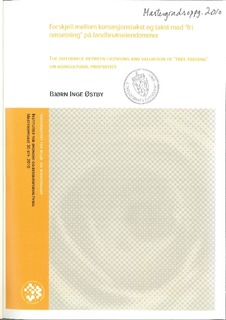| dc.description.abstract | Tema for oppgaven er taksering av konsesjonseiendommer, der fokuset er å klarlegge
forskjellen på konsesjonstakst og taksering med ”fri omsetning” av konsesjonspliktige
landbrukseiendommer.
Oppgaven er delt inn i fire deler, der første del er en teoridel om eiendomspriser og faktorer
tilknyttet landbrukseiendommer. I del to er det presentert lovverk og retningslinjer som har
betydning for konsesjonseiendommene. Del tre omhandler takseringsregler og retningslinjer
takstmennene må forholde seg til i forhold til konsesjonstaksering. Den fjerde og siste delen
av oppgaven er hoveddelen. Her presenteres undersøkelsen og resultatene av denne.
Empirien til masteroppgaven er innhentet gjennom en spørreundersøkelse der fire takstmenn
til sammen har taksert ti ulike konsesjonseiendommer. På bakgrunn av disse takseringene skal
takstmennene kommentere om det har blitt noen forskjeller i verdsettingen med ”fri
omsetning” og konsesjonstakst.
De faktoren jeg har antatt vil medføre forskjeller, og som jeg har bet takstmennene om å
kommentere er: kapitaliseringsrente, bygninger, boverdi, utbygningsmuligheter, verdiberegning på stående kubikkmasse i skogen, tømmerpriser, jakt- og fiskerettigheter, årlig jordverdi, boplikt. Takstmennenes kommentarer viser at det er forskjeller ved de fleste av disse faktorene. For
enkelte av faktorene har takstmennene vurdert de to takstene likt. I forhold til de ulike
faktorene er det bare kapitaliseringsrenten og boverdi med det nye boverditillegget på 1,5
millioner som ikke vil påvirke takseringene for de eiendommene som er med i undersøkelsen.
Det betyr at kapitaliseringsrenten er den samme med de to takstformene og at grensen for
boverdi ikke vil skape forskjeller mellom takseringene. Alle de andre faktorene ville med ”fri
omsetning” ført til en forskjell på én eller flere eiendommer, men med varierende betydning.
Den faktoren som har påvirking på flest aktuelle takster er stående kubikkmasse. I de tilfeller eiendommen hadde potensiell utbygning førte ofte dette til en høyere takst, og det var denne
faktoren som skapte de største forskjellene mellom takstene. This study focuses on assessment of licensing properties, where the focus is to clarify the
difference between licensing valuation and assessment of "free trading" of licensed
agricultural properties.
The thesis is divided into four parts, where the first part is a theoretical part about property
prices and factors associated with agricultural properties. In part two, it is submitted
legislation and policies that affect licensing properties. Part three deals with valuation rules
and regulations appraisers must deal with in relation to the licensing jurisdiction. The fourth
and last part of the thesis is the main section. We present the survey and the results thereof.
Empirical to the master's thesis was obtained through a questionnaire in which four appraisers
together have assessed ten different licensed properties. On the basis of these assessments
rings to rate the appraisers comment on whether there have been some differences in the
valuation of "free trading" and licensing charges.
The factors I have assumed will lead to differences are: Capitalization rate, Buildings, Living value, Development opportunities, Safety Computational standing cubic mass in the forest, Timber Prices, Hunting and fishing rights, Annual Land Value, Stay of duty. The appraiser’s comment shows that there are differences at most of these factors. For some
of the factors the appraisers rated the two charges equally. In relation to the different factors,
is it only the capitalization rate and living value, with the new supplement of 1,5 million, that
will not affect the inventories of the properties included in the survey. This means that the
capitalization rate is the same with the two valuation methods and the limit of living value not
want to create differences between assessments rings. All the other factors would with "free sale" led to a difference of one or more properties, but with varying significance. The factor
that has impact on the most current tariffs is standing cubic mass. In those cases, the property
had potential development. This often led to a higher valuation, and it was this factor that
created the biggest differences between charges. | en_US |
